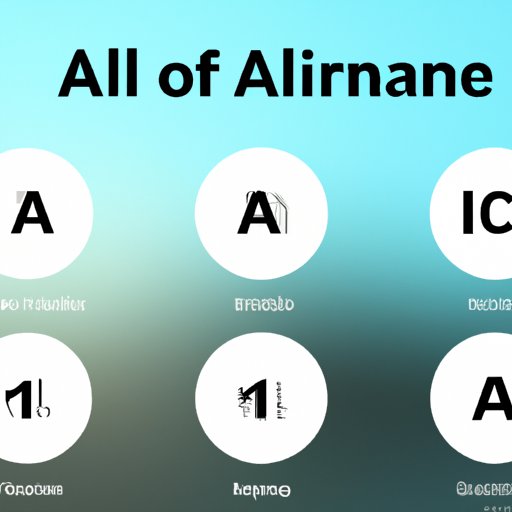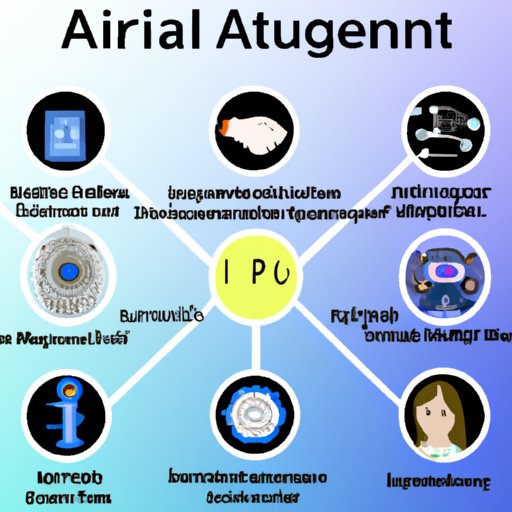Introduction
As technology advances, so does the range of artificial intelligence (AI) applications. From self-driving cars to virtual assistants, AI has become an integral part of our lives. But what is AI exactly? And how many types of AI are there? In this article, we explore the different types of AI, from weak AI (or narrow AI) to strong AI (or general AI) and super AI, as well as the various AI technologies and their capabilities.
Exploring the Various Branches of AI: What Are the Different Types of AI?
AI encompasses a broad set of technologies, from machine learning to natural language processing. To better understand the different types of AI, it’s important to first look at the different branches of AI. There are three main branches: weak AI, strong AI, and super AI.
Weak AI (Narrow AI)
Also known as narrow AI, weak AI is a form of AI that is programmed to perform specific tasks. It is not capable of “thinking” on its own and can only complete the tasks it is given. Examples of weak AI include virtual assistants like Siri and Alexa, as well as image recognition software. According to Professor Subbarao Kambhampati of Arizona State University, “Weak AI is AI that performs specific tasks within a limited scope.”
Strong AI (General AI)
Strong AI, also known as general AI, is a form of AI that is able to think and act independently. It is capable of understanding its environment and making decisions based on its observations. Strong AI is still in the early stages of development and is yet to be realized. As Professor Kambhampati explains, “Strong AI is AI that is able to think, reason, and make decisions on its own, without any human intervention.”
Super AI
Super AI is a form of AI that has surpassed human intelligence. It is capable of performing complex tasks that are beyond the scope of human capabilities. Super AI is still in the early stages of development and is yet to be realized. According to Professor Kambhampati, “Super AI is AI that is far more intelligent than the smartest humans.”

AI 101: An Overview of the Different Types of AI
Now that we’ve explored the different branches of AI, let’s take a closer look at the different types of AI. AI can be classified according to its capability, or the tasks it is capable of performing. The four types of AI are reactive machines, limited memory, theory of mind, and self-awareness.
Reactive Machines
Reactive machines are the simplest type of AI. They are capable of responding to stimuli from their environment but are unable to form memories or learn from past experiences. Examples of reactive machines include IBM’s Deep Blue chess computer and Google’s AlphaGo Go player. According to professor Kambhampati, “Reactive machines are AI systems that are able to respond to stimuli from their environment but are unable to form memories or learn from past experiences.”
Limited Memory
Limited memory AI is a type of AI that is capable of forming memories and using them to make decisions. These systems are able to store data from past experiences and use it to inform future decisions. Examples of limited memory AI include facial recognition systems and self-driving cars. As professor Kambhampati explains, “Limited memory AI is AI that is able to form memories and use them to make decisions.”
Theory of Mind
Theory of mind AI is a type of AI that is capable of understanding other people’s thoughts and feelings. This type of AI is still in the early stages of development and is yet to be realized. As professor Kambhampati explains, “Theory of mind AI is AI that is able to understand other people’s thoughts and feelings.”
Self-awareness
Self-awareness AI is a type of AI that is capable of understanding its own mental states and emotions. This type of AI is still in the early stages of development and is yet to be realized. According to professor Kambhampati, “Self-awareness AI is AI that is able to understand its own mental states and emotions.”

The Different Types of AI Technologies and How They Work
Now that we’ve explored the different types of AI, let’s take a closer look at the various AI technologies and how they work. AI technologies can be divided into five categories: machine learning, natural language processing, robotics, computer vision, and expert systems.
Machine Learning
Machine learning is a type of AI that is capable of learning from data and making decisions without being explicitly programmed. It uses algorithms to identify patterns in data and make predictions about future events. Examples of machine learning include facial recognition systems and recommendation engines. According to professor Kambhampati, “Machine learning is AI that is able to learn from data and make decisions without being explicitly programmed.”
Natural Language Processing
Natural language processing (NLP) is a type of AI that is capable of understanding and interpreting human language. It uses algorithms to analyze text and speech and generate responses. Examples of NLP include virtual assistants like Siri and Alexa. As professor Kambhampati explains, “Natural language processing is AI that is able to understand and interpret human language.”
Robotics
Robotics is a type of AI that is capable of performing physical tasks. It uses robots to automate tasks such as manufacturing, assembly, and transportation. Examples of robotics include self-driving cars and drones. According to professor Kambhampati, “Robotics is AI that is able to perform physical tasks.”
Computer Vision
Computer vision is a type of AI that is capable of recognizing objects in images and videos. It uses algorithms to analyze visual data and identify objects. Examples of computer vision include facial recognition systems and autonomous vehicles. As professor Kambhampati explains, “Computer vision is AI that is able to recognize objects in images and videos.”
Expert Systems
Expert systems are a type of AI that is capable of providing advice and recommendations. It uses algorithms to analyze data and provide insights. Examples of expert systems include financial advisors and medical diagnostics. According to professor Kambhampati, “Expert systems are AI that is able to provide advice and recommendations.”
Understanding the Different Types of AI: Classification by Capability
In addition to the different types of AI technologies, AI can also be classified according to its capability, or the tasks it is capable of performing. The three types of AI by capability are analytical AI, human-inspired AI, and humanized AI.
Analytical AI
Analytical AI is a type of AI that is capable of analyzing data and making decisions. It uses algorithms to identify patterns in data and make predictions about future events. Examples of analytical AI include facial recognition systems and recommendation engines. According to professor Kambhampati, “Analytical AI is AI that is able to analyze data and make decisions.”
Human-Inspired AI
Human-inspired AI is a type of AI that is inspired by human behavior and decision-making processes. It uses algorithms to mimic human behavior and make decisions. Examples of human-inspired AI include virtual assistants and chatbots. As professor Kambhampati explains, “Human-inspired AI is AI that is inspired by human behavior and decision-making processes.”
Humanized AI
Humanized AI is a type of AI that is designed to interact with humans on a personal level. It uses algorithms to understand and respond to human emotions. Examples of humanized AI include virtual agents and customer service bots. According to professor Kambhampati, “Humanized AI is AI that is designed to interact with humans on a personal level.”
A Layman’s Guide to the Different Types of Artificial Intelligence
As artificial intelligence continues to evolve and become more advanced, it is important to understand the different types of AI and how they work. AI can be used to improve decision-making, automate tasks, and enhance customer experiences. However, there are also challenges associated with implementing AI, such as privacy concerns and ethical considerations. Here are some steps to take when implementing AI.
Benefits of AI
AI can offer many benefits, such as improved decision-making, increased efficiency, and enhanced customer experiences. AI can also help reduce costs and increase profits. As professor Kambhampati explains, “AI can offer many benefits, such as improved decision-making, increased efficiency, and enhanced customer experiences.”
Challenges of AI
Implementing AI also presents some challenges, such as privacy concerns, ethical considerations, and job displacement. It is important to consider these issues when implementing AI. As professor Kambhampati explains, “Implementing AI also presents some challenges, such as privacy concerns, ethical considerations, and job displacement.”
Steps to Take When Implementing AI
When implementing AI, it is important to have a clear understanding of the different types of AI and their capabilities. It is also important to consider the potential benefits and challenges associated with AI, as well as the necessary steps for successful implementation. As professor Kambhampati explains, “When implementing AI, it is important to have a clear understanding of the different types of AI and their capabilities, as well as the potential benefits and challenges associated with AI.”
Conclusion
AI is becoming increasingly advanced, and understanding the different types of AI is essential for successful implementation. In this article, we explored the different types of AI, from weak AI (or narrow AI) to strong AI (or general AI) and super AI, as well as the various AI technologies and their capabilities. We also looked at the different types of AI by capability and discussed the benefits and challenges of implementing AI. By understanding the different types of AI and their capabilities, we can better prepare for the future of AI.
(Note: Is this article not meeting your expectations? Do you have knowledge or insights to share? Unlock new opportunities and expand your reach by joining our authors team. Click Registration to join us and share your expertise with our readers.)
